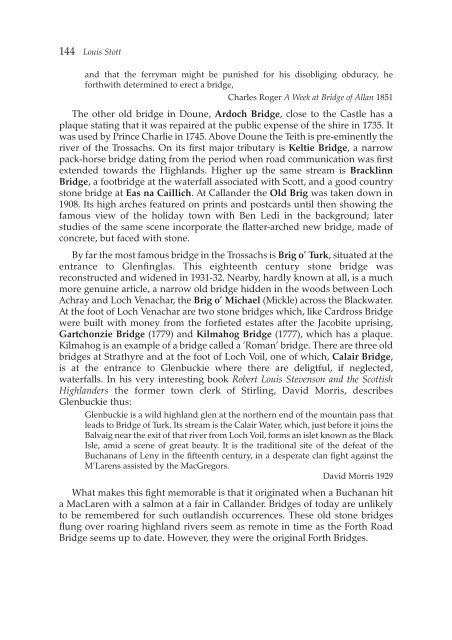the Forth Naturalist Historian - Forth Naturalist and Historian ...
the Forth Naturalist Historian - Forth Naturalist and Historian ...
the Forth Naturalist Historian - Forth Naturalist and Historian ...
Create successful ePaper yourself
Turn your PDF publications into a flip-book with our unique Google optimized e-Paper software.
144 Louis Stott<br />
<strong>and</strong> that <strong>the</strong> ferryman might be punished for his disobliging obduracy, he<br />
forthwith determined to erect a bridge,<br />
Charles Roger A Week at Bridge of Allan 1851<br />
The o<strong>the</strong>r old bridge in Doune, Ardoch Bridge, close to <strong>the</strong> Castle has a<br />
plaque stating that it was repaired at <strong>the</strong> public expense of <strong>the</strong> shire in 1735. It<br />
was used by Prince Charlie in 1745. Above Doune <strong>the</strong> Teith is pre-eminently <strong>the</strong><br />
river of <strong>the</strong> Trossachs. On its first major tributary is Keltie Bridge, a narrow<br />
pack-horse bridge dating from <strong>the</strong> period when road communication was first<br />
extended towards <strong>the</strong> Highl<strong>and</strong>s. Higher up <strong>the</strong> same stream is Bracklinn<br />
Bridge, a footbridge at <strong>the</strong> waterfall associated with Scott, <strong>and</strong> a good country<br />
stone bridge at Eas na Caillich. At Call<strong>and</strong>er <strong>the</strong> Old Brig was taken down in<br />
1908. Its high arches featured on prints <strong>and</strong> postcards until <strong>the</strong>n showing <strong>the</strong><br />
famous view of <strong>the</strong> holiday town with Ben Ledi in <strong>the</strong> background; later<br />
studies of <strong>the</strong> same scene incorporate <strong>the</strong> flatter-arched new bridge, made of<br />
concrete, but faced with stone.<br />
By far <strong>the</strong> most famous bridge in <strong>the</strong> Trossachs is Brig o’ Turk, situated at <strong>the</strong><br />
entrance to Glenfinglas. This eighteenth century stone bridge was<br />
reconstructed <strong>and</strong> widened in 1931-32. Nearby, hardly known at all, is a much<br />
more genuine article, a narrow old bridge hidden in <strong>the</strong> woods between Loch<br />
Achray <strong>and</strong> Loch Venachar, <strong>the</strong> Brig o’ Michael (Mickle) across <strong>the</strong> Blackwater.<br />
At <strong>the</strong> foot of Loch Venachar are two stone bridges which, like Cardross Bridge<br />
were built with money from <strong>the</strong> forfieted estates after <strong>the</strong> Jacobite uprising,<br />
Gartchonzie Bridge (1779) <strong>and</strong> Kilmahog Bridge (1777), which has a plaque.<br />
Kilmahog is an example of a bridge called a ‘Roman’ bridge. There are three old<br />
bridges at Strathyre <strong>and</strong> at <strong>the</strong> foot of Loch Voil, one of which, Calair Bridge,<br />
is at <strong>the</strong> entrance to Glenbuckie where <strong>the</strong>re are deligtful, if neglected,<br />
waterfalls. In his very interesting book Robert Louis Stevenson <strong>and</strong> <strong>the</strong> Scottish<br />
Highl<strong>and</strong>ers <strong>the</strong> former town clerk of Stirling, David Morris, describes<br />
Glenbuckie thus:<br />
Glenbuckie is a wild highl<strong>and</strong> glen at <strong>the</strong> nor<strong>the</strong>rn end of <strong>the</strong> mountain pass that<br />
leads to Bridge of Turk. Its stream is <strong>the</strong> Calair Water, which, just before it joins <strong>the</strong><br />
Balvaig near <strong>the</strong> exit of that river from Loch Voil, forms an islet known as <strong>the</strong> Black<br />
Isle, amid a scene of great beauty. It is <strong>the</strong> traditional site of <strong>the</strong> defeat of <strong>the</strong><br />
Buchanans of Leny in <strong>the</strong> fifteenth century, in a desperate clan fight against <strong>the</strong><br />
M’Larens assisted by <strong>the</strong> MacGregors.<br />
David Morris 1929<br />
What makes this fight memorable is that it originated when a Buchanan hit<br />
a MacLaren with a salmon at a fair in Call<strong>and</strong>er. Bridges of today are unlikely<br />
to be remembered for such outl<strong>and</strong>ish occurrences. These old stone bridges<br />
flung over roaring highl<strong>and</strong> rivers seem as remote in time as <strong>the</strong> <strong>Forth</strong> Road<br />
Bridge seems up to date. However, <strong>the</strong>y were <strong>the</strong> original <strong>Forth</strong> Bridges.



